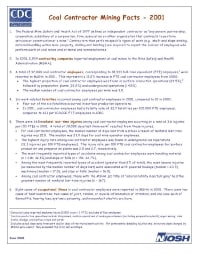Mining Publication: Coal Contractor Mining Facts - 2001
Original creation date: June 2003
Authors: National Institute for Occupational Safety and Health
The Federal Mine Safety and Health Act of 1977 defines an independent contractor as "any person, partnership, corporation, subsidiary of a corporation, firm, association or other organization that contracts to perform services or construction at a mine." Contractors that perform specific types of work (e.g., shaft and slope sinking, material handling within mine property, drilling and blasting) are required to report the number of employees who perform work at coal mines and at metal and nonmetal mines. In 2001, 2,909 contracting companies reported employment at coal mines to the Mine Safety and Health Administration (MSHA). A total of 32,049 coal contractor employees, corresponding to 18,333 full-time equivalent (FTE) employees, were reported to MSHA in 2001. This represents a 12.0% increase in FTE coal contractor employees from 2000. The highest proportion of coal contractor employees was found in surface production operations (63.5%), followed by preparation plants (22.0%) and underground operations (14.5%). The median number of coal contractor employees per mine was 3.0. Six work-related fatalities occurred among coal contractor employees in 2001, compared to 10 in 2000. Four out of the six fatalities occurred in surface production operations. In 2001, coal contractor employees had a fatality rate of 32.7 fatalities per 100,000 FTE employees, compared to 61.1 per 100,000 FTE employees in 2000. There were 665 nonfatal lost-time injuries among coal contractor employees occurring at a rate of 3.6 injuries per 100 FTEs in 2001. A total of 39,099 days lost from work 3 resulted from these injuries. For coal contractor employees, the median number of days lost from work as a result of nonfatal lost-time injuries was 15.0. The median was 12.0 days for coal mine operator employees. The highest injury rate among coal contractor employees was found in underground coal operations (12.3 injuries per 100 FTE employees). The injury rate per 100 FTE coal contractor employees for surface production and preparation plants was 2.0 and 2.7, respectively. The most frequently reported types of accidents among coal contractor employees were handling material (n = 218; 32.8%) and slips or falls (n = 151; 22.7%). Among the most frequently reported types of accident (greater than 5% of total), the most severe injuries (as measured by the median number of days lost) were associated with powered haulage (median = 20.5), machinery (median = 17.0), and slips or falls (median = 16.0). Among coal contractor employees, those with the MSHA job title of "laborer/utility man/bull gang" had the greatest number of nonfatal lost-time injuries (n = 167). Eight cases of occupational illness in coal contractor employees were reported to MSHA in 2001. There were two cases of heat/sunstroke; two cases of joint, tendon, or muscle inflammation or irritation; and one case each of dermatitis, hearing loss, systemic poisoning, and noncontact electric arc burn.
